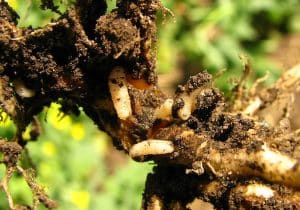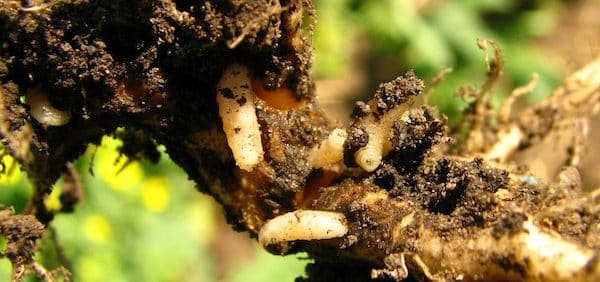Cabbage seedpod weevil. The economic threshold for applying insecticides is 25 to 40 weevils in 10 sweeps. Those sweeps should be done at very early canola flowering, and if fields are over threshold, spraying should occur when crops are at 10 to 20 per cent flower. Reports from Alberta suggest lower numbers so far, but some areas in Southern Alberta are at thresholds. See the Alberta map. Read more in the Canola Encyclopedia.
Spraying for lygus and CSPW at the same time. According to recent research by AAFC in Alberta, cabbage seedpod weevil and lygus do not become pests in the same fields. Early planted fields with high weevil numbers tend to have very low lygus populations. Thus, there is no economic return to spray for lygus at early flower in early-seeded fields.
What if you have multiple insect species near threshold in one field? An “additive” effect is possible when more than one species are feeding on key yield-producing areas — flowers, buds or pods — at the same time. For example, bertha armyworm, diamondback moth larvae and zebra caterpillar can be feeding on pods at the same time. See thresholds for major insects of canola.
Root maggots. They can cause premature ripening, similar to some diseases. In fact, root maggot damage can increase the amount of root rot damage. If the plant taproot breaks off slightly below the soil surface then root maggots are likely suspects. Look for maggots or tunneling. If the plant is girdled at or slightly above the soil surface, and taproots are not tunneled by root maggots, then a disease is more likely. No insecticides are registered or provide an economic benefit on root maggots. Crop rotation can provide effective management when numbers are high enough to cause yield loss.

Diamondback moths on buds. We heard some reports of larvae feeding on canola buds in Manitoba’s Parkland region. While economic damage usually doesn’t occur until the pod stage, keep an eye on fields where diamondback moths or larvae were spotted at any time through the year. Populations can build through numerous generations in a season. While beneficial insects usually keep these populations below economic levels, scout just in case. How to scout.

